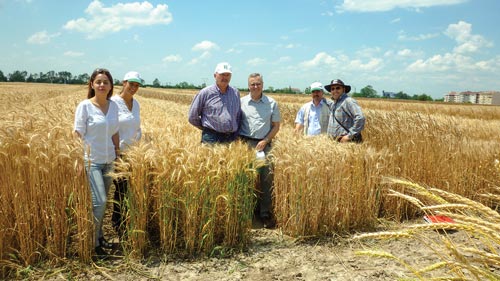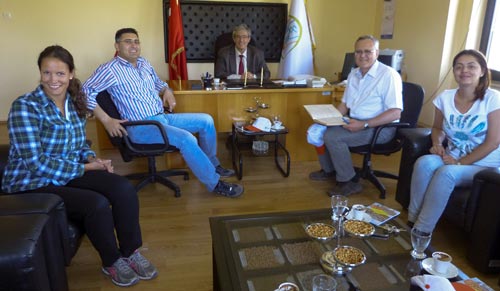By Abdelfattah A. Dababat and Dietrich Hermann/CIMMYT
CIMMYT has been working with agriculture research institutes in Turkey since the mid-1980s, focusing on developing germplasm that is broadly adapted and generates stable yields across a changing environment. The seed also must be more droughttolerant, resistant to diseases and cold temperatures and have winter hardness.
In 2000 CIMMYT-Turkey agreed to establish the Soil Borne Pathogens (SBP) program to work on root diseases such as cereal cyst nematodes, root lesion nematodes and dryland crown rot. In 2009 the SBP program at CIMMYT-Turkey started collaborating with Syngenta to explore possibilities to control SBPs on wheat. The idea was to use seed treatments on wheat germplasm having different resistance reactions to the SBP to investigate if the seed treatments showed additive and/or synergetic effects on both susceptible and resistant germplasm.

In order to get a more comprehensive understanding of the way CIMMYT Turkey works with agricultural research institutes, Dr. Dietrich Hermann and Dr. Monika Scheller from Syngenta Crop Protection AG in Basel, Switzerland, visited the SBP program 9-12 June. They were hosted by Dr. Abdelfattah A. Dababat and Dr. Gül Erginbas-Orakci. The visit started at the Trakya Agriculture Research Institute (TARI) in Edirne. TARI has been working on main crops such as sunflowers, rice, wheat, barley, oats, soybeans, safflower, flax, canola and pasture and forage crops to develop new, high-quality cultivars that have high yield and adaptation capabilities. Other projects include new agronomy techniques to increase farmer income, determining alternative crops for the region and producing elite and certified seed for seed producers and farmers.

The institute also contributes to Turkey’s agricultural economy with research on agronomy, pests and diseases; technological studies; and extension services. Guided by the institute’s director, Dr. Adnan Tulek, the group visited a wheat gall nematodes trial and discussed their life cycle and importance. They also toured the SBP nurseries and saw the best lines with multiple disease resistance traits. Dr. Alexei Morgounov, leader of the International Winter Wheat Improvement Program (IWWIP), showed some of the program’s seed multiplication plots as well as the landraces nursery. IWWIP is a joint enterprise of the government of Turkey, CIMMYT and the International Center for Research in Dry Areas (ICARDA).
IWWIP’s main objective is to develop winter/ facultative wheat germplasm for Central and West Asia. The following day the group visited the Transitional Zone Agriculture Research Institute (TZARI) in Eskisehir and met with Dr. Sabri Çakir, TZARI’s director, who briefed the visitors about the institute’s main activities. TZARI’s primary focus is improving yield potential and drought tolerance, particularly in winter wheat varieties.
TZARI has released 21 bread wheat varieties suited for dry conditions, 10 bread wheat varieties for irrigated conditions, five durum wheat, two triticale, 11 barley and two oat varieties, plus a range of germplasm for other crops (cabbage, chickpeas, common vetch, cumin, green beans, lentils, melons, onions, peppers, poppies, safflower, tomatoes and turnips). The group saw SBP activities in the lab, growth room, greenhouses and semi-field, addressed technical details and discussed possibilities for future collaborative work. Dr. Mustafa Cakmak, a TZARI wheat breeder, gave a tour of the field trials at the institute station and briefed the researchers on the IWWIP materials planted under both drought and irrigated conditions.
The Syngenta scientists gave presentations to breeders, pathologists and agronomists at both locations. Scheller provided an overview of Syngenta’s cereal seed care-product portfolio, and Hermann offered insight on the Syngenta strategy in barley and wheat, for seeds and crop protection, as well as opportunities seen in integration across technologies. The number of questions and the intensity of the discussion indicated the national scientists had significant interest in learning more about Syngenta’s technologies such as hybrid barley and seed care products. Hermann and Scheller will explore the possibility of increased interaction between the two institutes and the local Syngenta team in Turkey. The tour, which also offered opportunities for intensive discussion during the travel time between locations, was highly appreciated by the guests from Syngenta and will further increase the trust and strategic links between the organizations.
 Capacity development
Capacity development 
